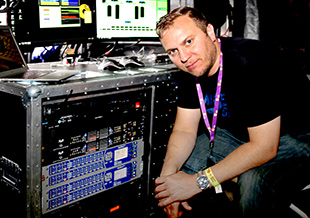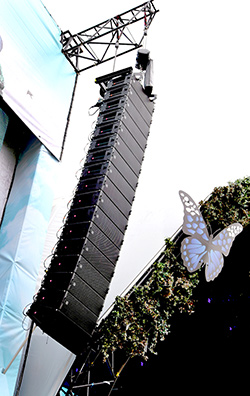![]() Now a music and broadcast tradition, the Proms in the Park celebrations attract thousands to outdoor venues in London, Northern Ireland, Wales and Scotland, and is broadcast live on TV and radio. Each event centres on a live concert with its own high-profile artists, BBC orchestras and presenters.
Now a music and broadcast tradition, the Proms in the Park celebrations attract thousands to outdoor venues in London, Northern Ireland, Wales and Scotland, and is broadcast live on TV and radio. Each event centres on a live concert with its own high-profile artists, BBC orchestras and presenters.
Capital Sound took on the Hyde Park event, providing an Optocore fibre-optic audio network infrastructure and Martin Audio MLA loudspeaker system.
 The BBC Concert Orchestra deliverd a selection of choral music and opera, and ‘classical for starters’ under the baton of Richard Balcombe, and featuring guest tenor Vittorio Grigolo and soprano Pumeza Matshikiza. In addition, Rufus Wainwright and Earth, Wind & Fire joined the 2014 bill. The varied demands presented by the line-up and fast changes from band to orchestra to single voice announcement are joined by concerns over sound spill to make Capital Sound’s task exacting.
The BBC Concert Orchestra deliverd a selection of choral music and opera, and ‘classical for starters’ under the baton of Richard Balcombe, and featuring guest tenor Vittorio Grigolo and soprano Pumeza Matshikiza. In addition, Rufus Wainwright and Earth, Wind & Fire joined the 2014 bill. The varied demands presented by the line-up and fast changes from band to orchestra to single voice announcement are joined by concerns over sound spill to make Capital Sound’s task exacting.
‘Martin Audio MLA was the best solution for this event as there is a lot going on throughout and we are governed by very strict noise levels beyond the perimeter of the site,’ System Engineer, Toby Donovan explains. ‘We used a similar system earlier in the year during the Barclaycard British Summertime Festivals and it worked really well. One of the key features of MLA is that you can fine-tune the SPL profile across the whole site, whether it be an arena or an open-air festival. This means we can keep the SPL high in the audience areas, but we can keep noise pollution low beyond the barrier.’
The Optocore racks were also part fof the set-up for the Barclaycard British Summer Time Festival. The site configuration for Proms differed from British Summer Time, however, relocating closer to Mayfair’s busy Park Lane. ‘It meant the system had to be designed from the ground up because of its proximity to the road, but I managed to reduce the delay points to ten on the network – with the VIP structure being the other receiving source,’ says Capital Sound Technical Manager, Ian Colville.
Having added two X6R-FX devices to the Capital Sound inventory specifically for this event (taking the company’s tally to 12 interfaces), the system was set up to provide a fully redundant loop – this encompassed the ten delay positions as well as the VIP platform and covered veranda, all distributed from the FOH rack presided over by System Tech, Toby Donovan.
Capital Sound’s approach to signal transmission is logical and straightforward: ‘We feed the signal into the fibre network on an analogue input and take it out at each of the delay and VIP positions on AES-EBU and then into the Martin Audio Merlin network management system,’ Colville says.
Connectivity to the Martin Audio MLA PA VU Net/Ethernet control network, running dedicated Merlin management system, was via an Ethernet tunnel over Optocore. Subs at four of the delay points were on a separate feed.
Last noise of the Proms
 The MLA system allowed extremely smooth transition between main PA hang and delays across the site from the barrier at the front of the stage to the rear: ‘On this site we have a diverse audience both in taste and age range,’ Donovan explains. ‘Some like to sit up at the back, bring picnics and relax, while others like to dance down at the front. We have purposely incorporated a drop off across the site so if people want to find a quieter spot they can, however at the same time we want the output to be intelligible so that no one feels too far away from what’s happening.’
The MLA system allowed extremely smooth transition between main PA hang and delays across the site from the barrier at the front of the stage to the rear: ‘On this site we have a diverse audience both in taste and age range,’ Donovan explains. ‘Some like to sit up at the back, bring picnics and relax, while others like to dance down at the front. We have purposely incorporated a drop off across the site so if people want to find a quieter spot they can, however at the same time we want the output to be intelligible so that no one feels too far away from what’s happening.’
For Proms the main hang either side of the stage comprised 16 MLA boxes with one single MLD down fill supported by side hangs made up of 12, plus one down fill. In addition there was a 26 MLX broadside array with17 forward-firing MLX and nine rear firing MLX boxes on top – to provide the rejection required on stage and offsite in the far field behind the stage. This is augmented by a field delay system that comprises ten delay towers each of which features seven MLA boxes plus a single down fill. For contingency there’s also a centre delay right at the back, which comprises ten boxes plus a single down fill.
 ‘MLA offers excellent coherency,’ Donovan says. ‘Every little detail of the mix is crystal clear, regardless of where you are on the field. What’s particularly impressive is the amount of rejection MLA provides both onstage behind and alongside the PA, especially for the orchestra. We haven’t had a single problem with headroom before feedback. MLA also has plenty of low end for rock music and although there are a number of pre-sets, including an orchestral preset, we’re only using the standard set-up, plus the additional low end, even for the orchestra.’
‘MLA offers excellent coherency,’ Donovan says. ‘Every little detail of the mix is crystal clear, regardless of where you are on the field. What’s particularly impressive is the amount of rejection MLA provides both onstage behind and alongside the PA, especially for the orchestra. We haven’t had a single problem with headroom before feedback. MLA also has plenty of low end for rock music and although there are a number of pre-sets, including an orchestral preset, we’re only using the standard set-up, plus the additional low end, even for the orchestra.’
Working with Donovan was Capital crew chief Andy May: ‘The site is very long but we’re also in the centre of London so ensuring noise levels are low beyond the boundary is a big focus for us. MLA is the ideal system for this as it can be programmed to put a virtual canopy on the sound and send it to ground at a specified distance,’ he says. ‘Capital Sound has done a number of propagation tests with the authorities here now and they now know exactly what they want.’
Taking care of visiting artists’ FOH engineers for Capital was Dave Roden, also to be found at FOH for the Stereophonics: ‘I am often sceptical when new products come out but the first time I heard MLA I was pleasantly surprised,’ he says. ‘I walked with my back to the PA away from the stage and it felt like the PA was coming with me – it just didn’t get any quieter. I used MLA on The Stereophonics’ last arena tour and it was the difference between a good result and a fantastic result. The coverage is amazing, as is the low end – I have walked from side to side on this site and the bottom end just doesn’t change at all. MLX is a powerful tool as a sub as well – plenty of clean headroom and it sounds very musical. On more sensitive sites such as Hyde Park it can buy performers a few extra dB at front of house, and that’s really valuable for us.’
Because this was a televised event, and nothing had to be visible above ground within camera shot, Capital Sound had also replaced its catenaries with Yellow Jacket cable protectors, using around 1km in total to provide an ‘invisible’ network.